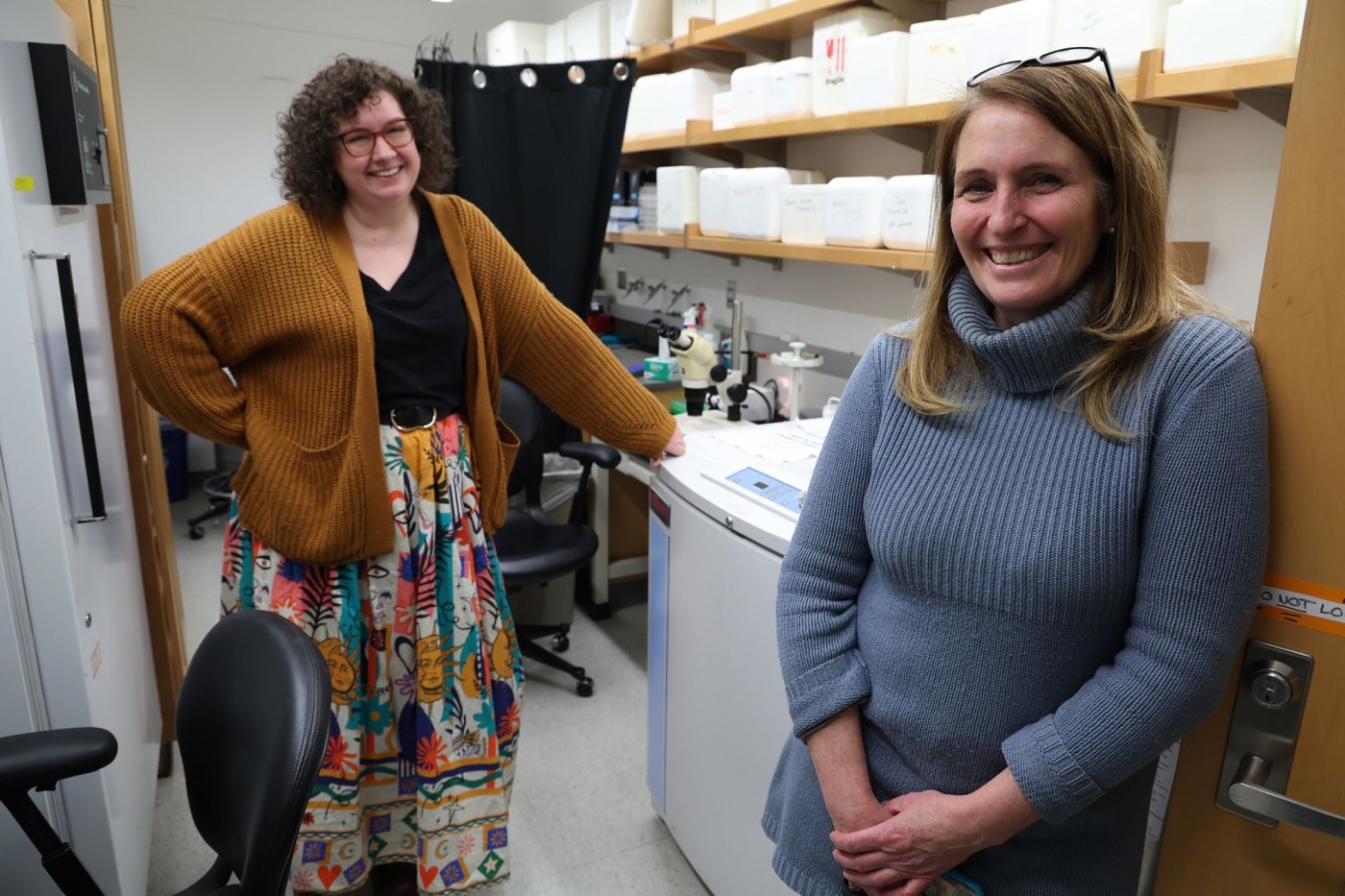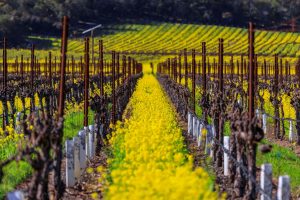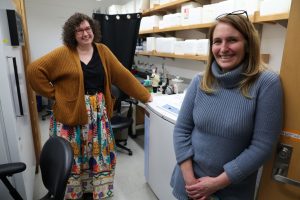
To make science more approachable, ‘Curiosity’ series takes viewers behind the scenes of scientists’ lives
CHICAGO — Stepping inside Erin Adams’ lab at the University of Chicago is a bit overstimulating.
Adams’ work centers on molecular immunology. As the Joseph Regenstein Professor of Biochemistry and Molecular Biology and vice provost for research, she researches the molecular signals that the immune system uses to distinguish between healthy and unhealthy tissue.
And her lab is expansive. It includes a tissue culture lab space — where she and her team of postdoctoral fellows work with cells to try to recapitulate things. Then there’s the crystal room where one can find hundreds of labeled wells filled with proteins that are being watched to see if three-dimensional crystals materialize.
Microscopes sit nearby to examine crystals that look like hexagonal discs. And liquid nitrogen is used for long-term storage of cells. Researchers on Adams’ team routinely pull “aliquots” for experiments. An aliquot is a vial of cells used for cellular experiments, said research associate Caitlin Castro.
Then there’s the larger lab space where postdoctoral scholars are working on their own projects under Adams’ tutelage. Lab coats, beakers, vials, tubes and other breakables sit on surfaces near what Adams calls a Playboy centerfold poster of crystals, which shows their different shapes and colors.
“It’s a place of exhilaration and frustration, because much of science ends in failure,” said Adams, of Jackson Park. “It’s never one person doing one project; it’s usually always several groups that are doing similarly related projects. It’s very competitive. It can be heartbreaking because you can have a group that publishes before you do and then the significance of what you’ve worked on for the last five years is diminished. That’s the reality of science.”
Adams’ world was featured in the 47-minute film “Serendipity,” produced and directed by a team of scientists and artists under the umbrella of The STAGE Lab, short for Scientists, Technologists and Artists Generating Exploration, at the University of Chicago’s Pritzker School of Molecular Engineering. “Serendipity” was shown on the U. of C.’s campus earlier this month.
It’s the second film in the “Curiosity: The Making of a Scientist” documentary series, an ongoing project that hopes to educate the public on what a career in science looks like, said Sunanda Prabhu-Gaunkar, STAGE Lab’s director of science and the docuseries director.
Nicole Ladd works in a lab at the Gordon Center for Integrative Science at the University of Chicago on Jan. 5, 2024. (Terrence Antonio James/Chicago Tribune/TNS)
Prabhu-Gaunkar said there’s a curiosity and an awareness about the sciences, but an understanding of day-to-day science is limited. “The Big Bang Theory” TV series was an entree into it. But she’s hoping that with STAGE dedicating a focused lens on scientists like Adams and Nate Earnest-Noble, the subject of the first film and a researcher in quantum physics, more people will see science as accessible.
“I think the big advantage at STAGE is that it’s artists and scientists working together at an equal level, sitting together and working through the process of making a film and learning from each other and that shows in the final product as well because that makes it authentic,” she said. “Spouses of scientists have come to me and said, ‘Now I understand what my husband is doing … I had no idea why he is working so late at night.’”
STAGE, the brainchild of Fiona Goodchild, education director at the California NanoSystems Institute at the University of California at Santa Barbara, started in the early 2000s when Nancy Kawalek, STAGE Lab’s founding director, was at the institute.
What began as a script competition to produce an original science play, given Kawalek’s background in theater and the arts, evolved into the current STAGE setup in Hyde Park in 2013. With lab space in the building where campus security resides and a 2,000-square-foot black box theater that can be configured in any way for productions, STAGE is integrating art and science as a way to tell stories of accidental discoveries and scientific breakthroughs via theater, film, and even gaming and social media influencers.
Kawalek likens the STAGE films to the TV show “Inside the Actors Studio,” but instead of Hollywood celebrities talking about their careers and craft, it’s the back stories of scientists.
“Science is so underappreciated and so important,” she said. “We’ve just come off of this tremendous pandemic, and if that didn’t show us the importance of science, nothing has. Just saying to people, ‘Go get a vaccine; it’s good for you,’ nobody’s gonna listen to that. People want to have an emotional experience. They either want to be moved or laugh or have fun. That’s what sticks with them. That’s what gets them interested in things — and that’s at the heart of what we do.”
In “Serendipity,” we see Adams’ trajectory into science. It began with her answering a help wanted ad in a newspaper for a research technician at Stanford University after she finished college, she said.
Sean Ryan, left, a graduate student at the University of Chicago, removes vials of frozen cells as Erin Adams, an immunology professor, watches at the Gordon Center for Integrative Science at the University of Chicago on Jan. 5, 2024. (Terrence Antonio James/Chicago Tribune/TNS)
Adams shares the highs and lows she has endured in the field, many of which have been serendipitous, hence the film’s title, including a scientific breakthrough that led to her tenured position and the birth of her son, August.
“Nate (Earnest-Noble) had this really challenging childhood,” Kawalek said. “He lost both his parents by the age of 16. It hasn’t been the easiest for him, even getting his Ph.D., but the fact that he could do that, I think is significant. Someone like Erin (Adams), she had challenges of a different kind growing up and didn’t take high school seriously; then you see the success she has achieved. Those kinds of stories lend themselves to a kind of relatability. … It lets people see that science is for everyone. You don’t have to be a genius.
“We want people to understand from seeing these stories, and being able to relate to them on a human level, how important science is. It’s such a part of our lives and I don’t mean just medical advances. What makes our refrigerators work, what makes our smartphones work, what about the clothes we wear? What makes a Band-Aid stick, what makes a Band-Aid sterile? These are all things that come out of different areas of science. And if the public can appreciate that, maybe they won’t be so fearful of science.”
Prabhu-Gaunkar, an electrical engineer, learned filmmaking to step into her role at STAGE because she saw the disconnect from science in the real world when she was working for a product design company in downtown Chicago on a nanotechnology project.
“I realized their idea of science was totally different from what I lived as a scientist,” she said.
Prabhu-Gaunkar said she and the students involved with the project have a lot of conversations about their notion of what science is: “You have to be good at math. You have to be able to do equations.”
It’s not that, she said.
“While making the film, students discover what is the science process — how do you do it?” she said. “You have to be iterating your ideas all the time and have to be ready for everything failing because inherently you are making something new, which has never been done before, so it’s not clear that it will work. That is the nature of science and you have to be ready for that.”
Prabhu-Gaunkar said the goal of “Curiosity: The Making of a Scientist” is to expand it to feature scientists of different ages, genders and backgrounds. Prabhu-Gaunkar said as “Curiosity” expands, she envisions more films and wider distribution.
The next film will focus on octogenarian physicist Walter Massey. “Serendipity” has already won awards from a number of film festivals. “We are trying to show people who have come from different places into science,” Prabhu-Gaunkar said. “Somehow there was a reason why they came to science and see what they made of that opportunity.”
“We recognize the importance of being able to open up the silo and have people see in and understand what we’re doing here,” Adams said of STAGE’s mission.
She let the team follow her around for two years to capture her story, a snapshot in time. Adams’ son was 3 when filming began; he’s now in second grade.
“Science tends to be really high on a hill for people and something a lot of people don’t think they can ever achieve, but there is a path to getting there for everybody,” she said. “We need more people to be passionate about science, we need more kids to be passionate about science … this is a place where people can really explore their passions, and in exploring those passions have these revolutionary breakthroughs.”
___
©2024 Chicago Tribune. Visit at chicagotribune.com. Distributed by Tribune Content Agency, LLC.


